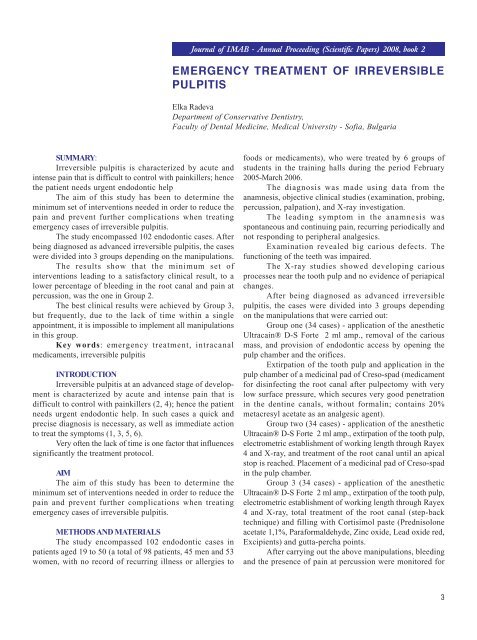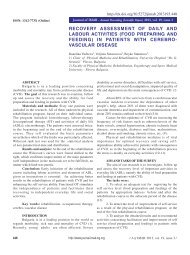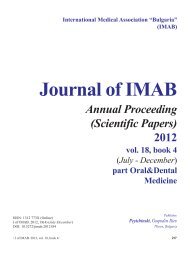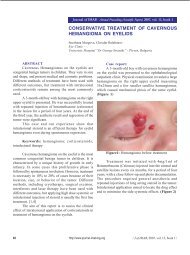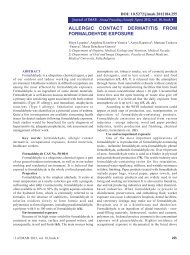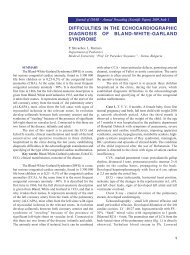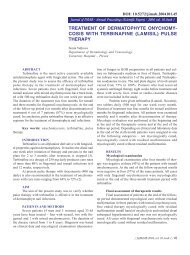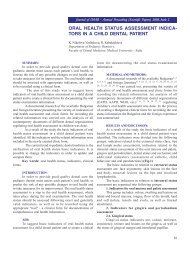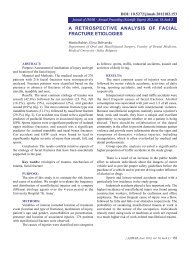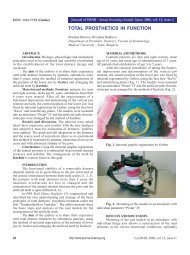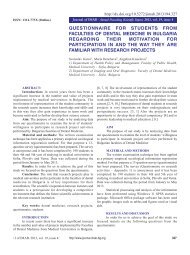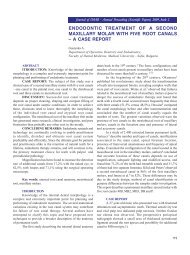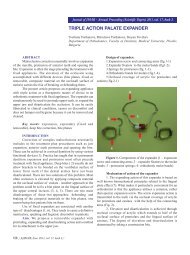emergency treatment of irreversible pulpitis - Journal of IMAB
emergency treatment of irreversible pulpitis - Journal of IMAB
emergency treatment of irreversible pulpitis - Journal of IMAB
Create successful ePaper yourself
Turn your PDF publications into a flip-book with our unique Google optimized e-Paper software.
<strong>Journal</strong> <strong>of</strong> <strong>IMAB</strong> - Annual Proceeding (Scientific Papers) 2008, book 2<br />
EMERGENCY TREATMENT OF IRREVERSIBLE<br />
PULPITIS<br />
Elka Radeva<br />
Department <strong>of</strong> Conservative Dentistry,<br />
Faculty <strong>of</strong> Dental Medicine, Medical University - S<strong>of</strong>ia, Bulgaria<br />
SUMMARY:<br />
Irreversible <strong>pulpitis</strong> is characterized by acute and<br />
intense pain that is difficult to control with painkillers; hence<br />
the patient needs urgent endodontic help<br />
The aim <strong>of</strong> this study has been to determine the<br />
minimum set <strong>of</strong> interventions needed in order to reduce the<br />
pain and prevent further complications when treating<br />
<strong>emergency</strong> cases <strong>of</strong> <strong>irreversible</strong> <strong>pulpitis</strong>.<br />
The study encompassed 102 endodontic cases. After<br />
being diagnosed as advanced <strong>irreversible</strong> <strong>pulpitis</strong>, the cases<br />
were divided into 3 groups depending on the manipulations.<br />
The results show that the minimum set <strong>of</strong><br />
interventions leading to a satisfactory clinical result, to a<br />
lower percentage <strong>of</strong> bleeding in the root canal and pain at<br />
percussion, was the one in Group 2.<br />
The best clinical results were achieved by Group 3,<br />
but frequently, due to the lack <strong>of</strong> time within a single<br />
appointment, it is impossible to implement all manipulations<br />
in this group.<br />
Key words: <strong>emergency</strong> <strong>treatment</strong>, intracanal<br />
medicaments, <strong>irreversible</strong> <strong>pulpitis</strong><br />
INTRODUCTION<br />
Irreversible <strong>pulpitis</strong> at an advanced stage <strong>of</strong> development<br />
is characterized by acute and intense pain that is<br />
difficult to control with painkillers (2, 4); hence the patient<br />
needs urgent endodontic help. In such cases a quick and<br />
precise diagnosis is necessary, as well as immediate action<br />
to treat the symptoms (1, 3, 5, 6).<br />
Very <strong>of</strong>ten the lack <strong>of</strong> time is one factor that influences<br />
significantly the <strong>treatment</strong> protocol.<br />
AIM<br />
The aim <strong>of</strong> this study has been to determine the<br />
minimum set <strong>of</strong> interventions needed in order to reduce the<br />
pain and prevent further complications when treating<br />
<strong>emergency</strong> cases <strong>of</strong> <strong>irreversible</strong> <strong>pulpitis</strong>.<br />
METHODS AND MATERIALS<br />
The study encompassed 102 endodontic cases in<br />
patients aged 19 to 50 (a total <strong>of</strong> 98 patients, 45 men and 53<br />
women, with no record <strong>of</strong> recurring illness or allergies to<br />
foods or medicaments), who were treated by 6 groups <strong>of</strong><br />
students in the training halls during the period February<br />
2005-March 2006.<br />
The diagnosis was made using data from the<br />
anamnesis, objective clinical studies (examination, probing,<br />
percussion, palpation), and X-ray investigation.<br />
The leading symptom in the anamnesis was<br />
spontaneous and continuing pain, recurring periodically and<br />
not responding to peripheral analgesics.<br />
Examination revealed big carious defects. The<br />
functioning <strong>of</strong> the teeth was impaired.<br />
The X-ray studies showed developing carious<br />
processes near the tooth pulp and no evidence <strong>of</strong> periapical<br />
changes.<br />
After being diagnosed as advanced <strong>irreversible</strong><br />
<strong>pulpitis</strong>, the cases were divided into 3 groups depending<br />
on the manipulations that were carried out:<br />
Group one (34 cases) - application <strong>of</strong> the anesthetic<br />
Ultracain® D-S Forte 2 ml amp., removal <strong>of</strong> the carious<br />
mass, and provision <strong>of</strong> endodontic access by opening the<br />
pulp chamber and the orifices.<br />
Extirpation <strong>of</strong> the tooth pulp and application in the<br />
pulp chamber <strong>of</strong> a medicinal pad <strong>of</strong> Creso-spad (medicament<br />
for disinfecting the root canal after pulpectomy with very<br />
low surface pressure, which secures very good penetration<br />
in the dentine canals, without formalin; contains 20%<br />
metacresyl acetate as an analgesic agent).<br />
Group two (34 cases) - application <strong>of</strong> the anesthetic<br />
Ultracain® D-S Forte 2 ml amp., extirpation <strong>of</strong> the tooth pulp,<br />
electrometric establishment <strong>of</strong> working length through Rayex<br />
4 and X-ray, and <strong>treatment</strong> <strong>of</strong> the root canal until an apical<br />
stop is reached. Placement <strong>of</strong> a medicinal pad <strong>of</strong> Creso-spad<br />
in the pulp chamber.<br />
Group 3 (34 cases) - application <strong>of</strong> the anesthetic<br />
Ultracain® D-S Forte 2 ml amp., extirpation <strong>of</strong> the tooth pulp,<br />
electrometric establishment <strong>of</strong> working length through Rayex<br />
4 and X-ray, total <strong>treatment</strong> <strong>of</strong> the root canal (step-back<br />
technique) and filling with Cortisimol paste (Prednisolone<br />
acetate 1,1%, Paraformaldehyde, Zinc oxide, Lead oxide red,<br />
Excipients) and gutta-percha points.<br />
After carrying out the above manipulations, bleeding<br />
and the presence <strong>of</strong> pain at percussion were monitored for<br />
3
48 to 72 hours (bleeding in the root canal can be determined<br />
through the presence <strong>of</strong> blood on a cotton pad soaked in<br />
medicine, dried, and then placed in the pulp chamber).<br />
The data was processed with the statistics package<br />
SPSS 13.0.1. p


